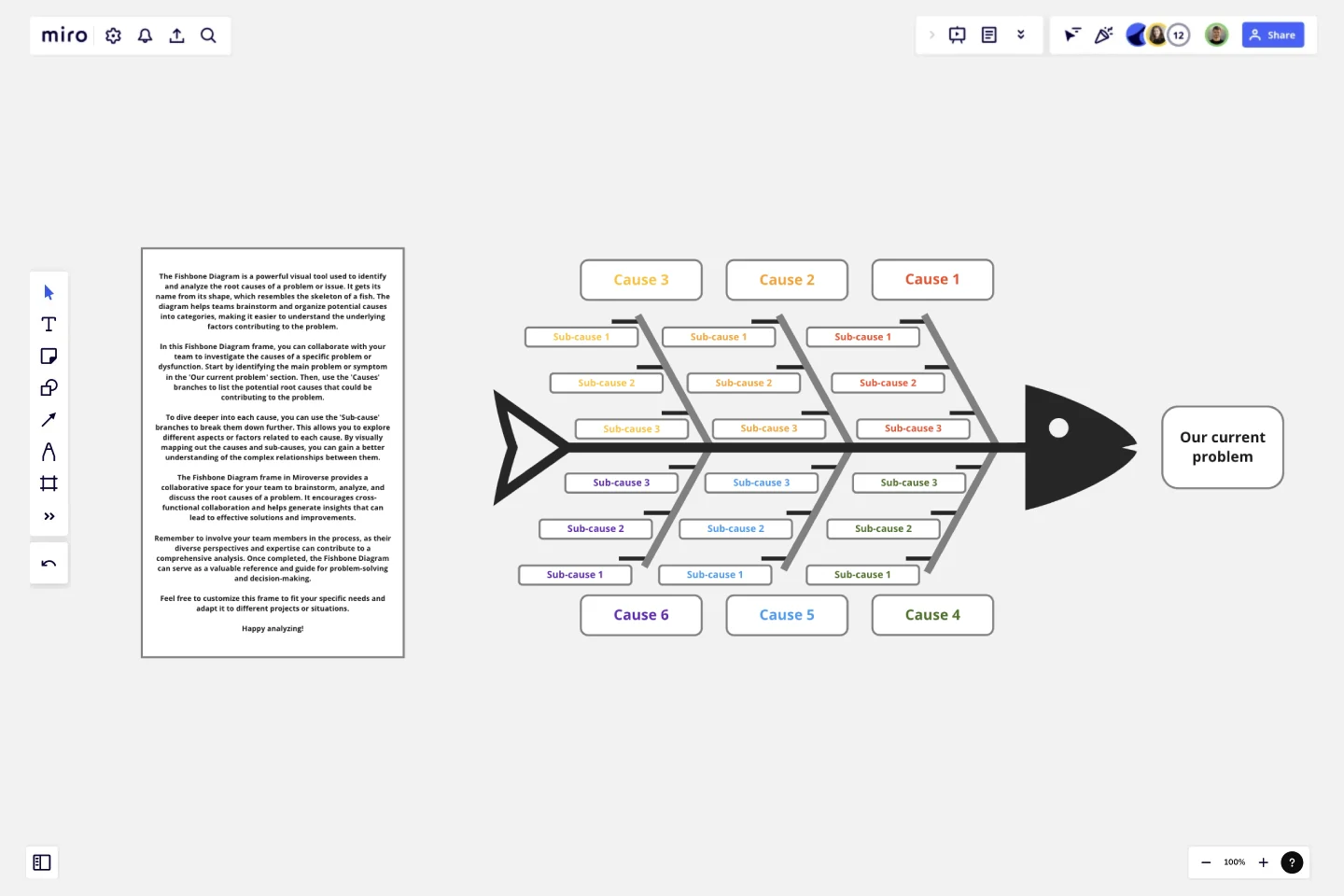Fishbone Diagram by Dave Westgarth
The Fishbone Diagram is a powerful visual tool used to identify and analyze the root causes of a problem or issue.
It gets its name from its shape, which resembles the skeleton of a fish. The diagram helps teams brainstorm and organize potential causes into categories, making it easier to understand the underlying factors contributing to the problem.
In this Fishbone Diagram frame, you can collaborate with your team to investigate the causes of a specific problem or dysfunction. Start by identifying the main problem or symptom in the 'Our current problem' section. Then, use the 'Causes' branches to list the potential root causes that could be contributing to the problem.
To dive deeper into each cause, you can use the 'Sub-cause' branches to break them down further. This allows you to explore different aspects or factors related to each cause. By visually mapping out the causes and sub-causes, you can gain a better understanding of the complex relationships between them.
The Fishbone Diagram frame in Miroverse provides a collaborative space for your team to brainstorm, analyze, and discuss the root causes of a problem. It encourages cross-functional collaboration and helps generate insights that can lead to effective solutions and improvements.
Remember to involve your team members in the process, as their diverse perspectives and expertise can contribute to a comprehensive analysis. Once completed, the Fishbone Diagram can serve as a valuable reference and guide for problem-solving and decision-making.
Feel free to customize this frame to fit your specific needs and adapt it to different projects or situations. Happy analyzing!
This template was created by Dave Westgarth.
Get started with this template right now.
A3 Report Template
Works best for:
Product, Strategy and Planning
The A3 report template is a carefully designed tool that provides teams with a structured and visual methodology to tackle challenges. It divides the problem-solving process into background, current context, data analysis, and implementation plans, ensuring a comprehensive approach to each issue. One of the major advantages of this template is its "Data Analysis" section, which enables teams to delve deeply into concrete insights and trends. This data-driven approach ensures that all recommendations and actions are based on real, tangible evidence rather than just intuition, leading to more effective and strategic decision-making.
User Centric Roadmap
Works best for:
Research & Design
Create user-focused product plans with the Workshop: How to Build a User Centric Roadmap template. This tool helps you prioritize features based on user needs and feedback. Use it to align your team around user-centric goals, ensuring your product development efforts are driven by real user insights. Ideal for product managers and teams looking to enhance their product's user experience and ensure it meets customer expectations effectively.
Basic Persona & Empathy Map
Works best for:
Product Management
Understand your customers better with the Basic Persona & Empathy Map template. This tool helps you create detailed personas and empathy maps, providing insights into customer needs, behaviors, and pain points. Use this template to tailor your products and services to meet customer expectations more effectively. Perfect for marketing and product development teams focused on user-centered design.
Product Backlog Template
Works best for:
Agile Methodology, Kanban Boards, Product Management
Development teams are often juggling many products at once. A product backlog is a project management tool that helps teams keep track of projects in flight as they build and iterate, so you can store everyone's ideas, plan epics, and prioritize tasks. The highest-priority tasks are at the top of the product backlog, so your team knows what to work on first. Product backlogs make it easier for teams to plan and allocate resources, but it also provides a single source of truth for everyone to know what development teams are working on.
Action Plan Template
Works best for:
Education, Project Management, Project Planning, Kanban
Why create an action plan? Long-term business strategies and goals are only good if you can make them a reality—by accomplishing every small task along the way. An action plan lists those tasks and lays them out in clear detail. It helps you keep everything in order, make sure nothing is missed, and get stakeholders on the same page to complete a project quickly and effectively. This template will help you write an action plan that’s SMART: Specific, Measurable, Actionable, Realistic, and Time-bound.
What's on Your Radar Template
Works best for:
Business Management, Operations, Strategic Planning
Do you or your team feel overburdened by tasks? Having trouble focusing on particular problems? What’s on Your Radar is a thought exercise in which you plot ideas according to their importance or relevance. Designers and teams use what’s on your radar to ensure that their ideas are within the scope of a given project. They also rely on the method to assess whether a given solution is likely to solve the problem at hand. But even if you’re not a designer, the method can help assign priorities and ground your ideas in reality.
